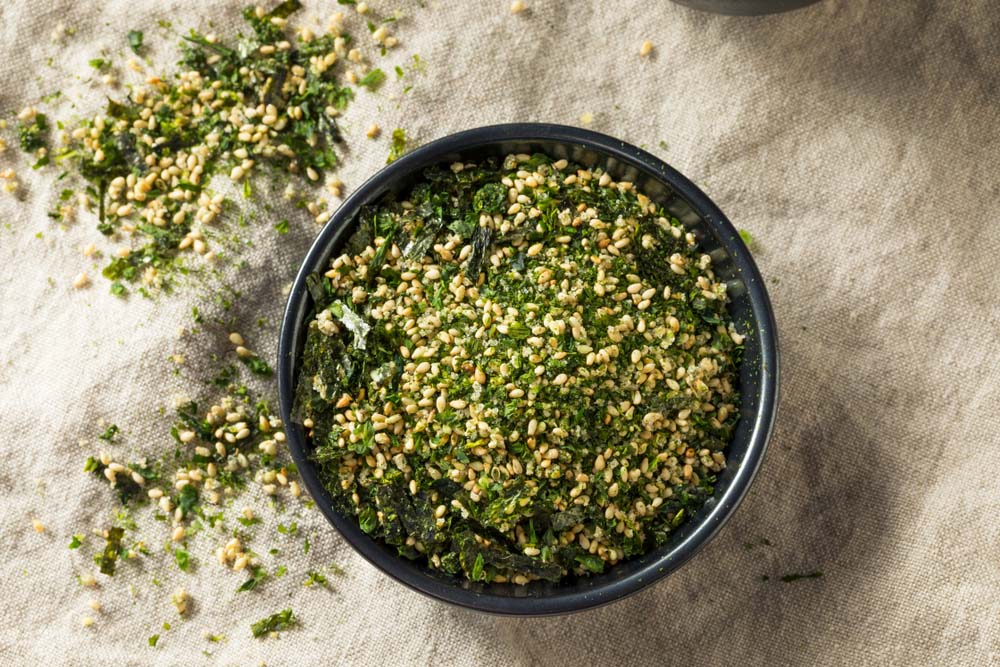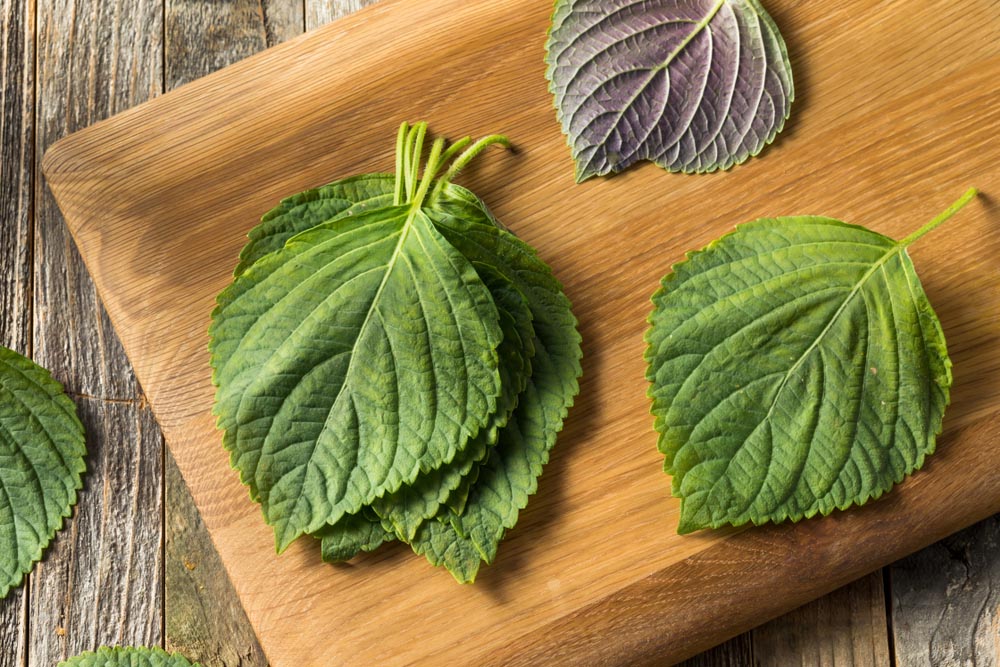
Shiso is one of the most flavorful culinary herbs that’s native to Japanese cuisine. It has a fresh and citrusy flavor with hints of mint, cinnamon, and cloves, which adds a diverse flavor to your dish.
In addition, it imparts a green and fresh aroma to the recipes. However, if you cannot find shiso, we have some substitutes that you can try!
Shiso Substitutes
- Thai Basil
Thai basil also belongs to the same family as shiso and is a common ingredient in Southeast Asian and Thai cuisines. It has a purple color like shiso, so it can replicate the appearance as well as the flavor. In particular, Thai basil has a spicy and minty flavor.
It has a floral and refreshing aroma that brightens up the food’s flavor. It’s easily available in grocery stores and can be grown in your kitchen garden as well. Thai basil retains its flavor when cooked, which is why you can use it for cooking recipes.
In addition, you can use Thai basil leaves as garnish. Overall, it adds unique pungency to the dishes, along with spicy and savory flavors.
- Mint
Mint belongs to the Lamiaceae family, just like shiso, which makes it a reliable alternative. It is a strong herb with a pungent flavor and aroma. It is extremely affordable and is readily available in local grocery stores.
It has a fresh aroma and adds a peppery yet sweet flavor to the recipes. It can be used to flavor sashimi, noodles, soups, and sushi. However, the mint leaves are smaller as compared to shiso, which is why you cannot use them for wrapping the meat.
What’s even more? It can be used as a garnish for food. It’s recommended that you only use fresh mint leaves to replace shiso. Also, the mint leaves remain fresh for over two weeks at room temperature.
- Furikake
Unlike other leafy alternatives, furikake is a dry seasoning that’s widely used in Japanese cuisines. This seasoning can be sprinkled on rice to add a fresh aroma. It is made from plums, red perilla, salt, nori, sesame seeds, and sugar, which results in a savory, sweet, and minty flavor.
However, if you want to add spicy notes, you can add chili flakes to the seasoning. In addition to rice, it can be used to flavor stews, pasta, and soups. In fact, furikake is also available in shiso flavor, known as shiso furikake. It is made from dried and seasoned red shiso leaves.
The shiso furikake can be used to add flavor to onigiri rice balls and sushi rolls. This seasoning has a shelf life of one year.
- Cilantro
Cilantro is popular for its refreshing and bright green color. The leaves have a soft texture, and it’s easy to find in grocery stores. The cilantro leaves are extremely thin yet fragrant and flavorful. It can be added to soups or as a garnish for the dishes.
Furthermore, cilantro has a potent flavor with lemony and grassy undertones. For this reason, it can be used to flavor umami noodles. Also, it tastes amazing with sashimi and Japanese rice.
Fresh cilantro has a pungent and peppery flavor, but it mellows down once the leaves are cooked, so it’s best that you add it at the end of the cooking process. If you use cilantro, make sure you remove the stems and chop the leaves. However, if you are preparing a sauce or pesto, you can grind the leaves and stems.
- Korean Perilla
Korean perilla is commonly known as egoma and is suitable to replace shiso in Korean recipes. Its leaves are commonly used to wrap grilled meat. However, it’s an exotic option, which means you can only find it in Korean grocery stores.
Korean perilla has mild grassy, minty, and peppery tones. It has green leaves with small flowers and purple stems, which is why it can be used as a garnish. However, if you have to cook with it, the stems and flowers must be removed.
The Korean perilla can be used in soups, stir-fries, and for wrapping meat. In addition, the leaves have an extremely sharp and strong scent, but it diminishes as you cook them. Also, make sure that the stems aren’t dried when you purchase the perilla. Lastly, avoid using the leaves if there are black or red dots on them.
- Umeboshi
Umeboshi is basically pickled plums with an abundance of red perilla. In particular, the plums absorb the flavor of red perilla, which is why they can be used to replace shiso. However, it has a darker color, which can change the appearance of your recipe.
Also, we recommend that you mince the pickled plums to add freshness to the recipe. Umeboshi also has sour undertones, which is why it can be used to flavor seafood.
- Myoga
Myoga is commonly known as Japanese ginger, and its taste is similar to shiso. It has pungent notes and adds a bitter yet refreshing flavor to the recipe. Myoga can add spice to the recipe and tastes amazing in sashimi and soba noodles. It has zesty tang and ginger overtones.
It’s better that you shred it thinly and use it as a topping rather than cooking, as it can lead to a bitter taste. Also, the dish should be served immediately after shredding and slicing myoga.
- Kaffir Lime Leaves
Fresh kaffir lime leaves can replace shiso in noodles and rice recipes. The leaves are bright green in color and have a shiny surface. In addition, the leaves have a citrusy aroma as well as a fresh, sweet, and tangy flavor.
Kaffir lime leaves are mostly used in Southeast Asian cuisines, but you can use them in Japanese and Korean dishes too. However, it’s recommended that you use the leaves for cooking recipes as cooking is important to extract the flavor.
The kaffir lime leaves can be used in stocks, stir-fries, and curries. Moreover, they can be cut into thin strips and used as a garnish. The leaves have a unique citrus flavor that can overpower other herbs, which is why they should be used in moderation.
They are available in the fresh herb sections of grocery stores and are sold in punnets but make sure the leaves are glossy and dark-green in appearance. The fresh leaves can be kept in a plastic bag for a week.
- Green Onions
Green onions are one of the most convenient alternatives that are readily available in local grocery stores. They have a versatile flavor profile and a mild aroma. In particular, green onions have a slightly sweet and grassy flavor.
Besides, the green onions have a fresh green color, which enhances the appearance of the dish. The green onions can be used to season the noodles and sashimi – it adds a very refreshing flavor.
- Lemon Basil
Lemon basil is another alternative for shiso because it has a slightly bitter and tangy flavor. It would be best to use lemon basil with mint leaves to add minty aroma and flavor to the recipe.
- Grape Leaf
The grape leaves are a great option for Mediterranean recipes. The leaves have a smooth and broad surface, which makes them suitable for wrapping meat. The grape leaves have a firm structure, so they can endure the long cooking process.
It’s recommended that you use fresh grape leaves to add a mild peppery and tangy flavor to the recipes. The grape leaves can be cut and added to the salad in chopped form. In addition, the grape leaves can be pickled with vinegar and brine for long-term storage and use.
The experts recommend using grape leaves to wrap the meat and rice mixtures rather than using them as an ingredient. However, if you have to mix the leaves with other ingredients, slice the leaves thinly and grill them.
The Bottom Line
Shiso is loved for its tangy and citrusy flavor. However, it may not be available at your nearby grocery store. We have put together a list of some healthy substitutes that can be used instead. All of them can be used in various recipes.






